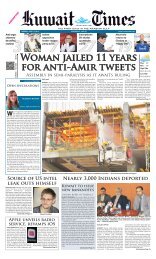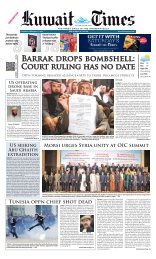KT 3-4-2013_Layout 1 - Kuwait Times
KT 3-4-2013_Layout 1 - Kuwait Times
KT 3-4-2013_Layout 1 - Kuwait Times
You also want an ePaper? Increase the reach of your titles
YUMPU automatically turns print PDFs into web optimized ePapers that Google loves.
WEDNESDAY, APRIL 3, <strong>2013</strong><br />
Psy’s new song<br />
features ‘Psy style’<br />
take<br />
37<br />
on Korean dance<br />
People wearing clown costumes ride a bicycle during the Humorina carnival in Odessa on April 1, <strong>2013</strong>. Thousands of people take part in Humorina, an annual festival of humor, in the southern Ukrainian city of Odessa on and<br />
around April Fools’ Day since 1973. — AFP<br />
San Francisco’s other<br />
Chinatown - the real one<br />
There are two Chinatowns in San Francisco, one where tourists can<br />
buy conical straw hats and tacky souvenirs, and a second where<br />
the locals live, shop and eat. There are no defined boundaries-you<br />
don’t cross a street and step from Tourist Chinatown to Authentic<br />
Chinatown. Rather, the two overlap. A visitor can leave a neon-lit store,<br />
loaded down with bamboo back scratchers and plastic Buddhas, and a<br />
half-block away turn down a dingy alley dotted with shops and businesses<br />
where no English is spoken.<br />
“Chinatown is not a closed attraction. Anybody can visit,” said Linda<br />
Lee, proprietor of All About Chinatown Walking Tours (allaboutchinatown.com),<br />
which has been showing people around for more than 30<br />
years. “Walk up Grant Avenue, the main street, then go to the rest (of the<br />
area) for authentic tours.”<br />
What Chinatown is is a bustling neighborhood. On one recent weekday<br />
morning, men and women jammed the sidewalks outside markets<br />
where oranges and mushrooms and other produce-some strikingly exotic-were<br />
sold along with live fish and crabs; an elderly gentleman shuffled<br />
down the street, Chinese music blaring from a radio under his coat; laundry<br />
hung on balconies and from clotheslines strung over narrow alleys.<br />
This is everyday life in Chinatown, and visitors are welcome. Any<br />
street in Chinatown will have an authentic shop or business or two. But<br />
explore side streets and alleys. For example, Waverly Place, on a long<br />
block between Washington and Clay streets, has beautiful architecture as<br />
well as a plethora of delightful smells. Cut down Ross Alley, between<br />
Jackson and Washington streets, and you’ll find the Golden Gate Fortune<br />
Cookie Factory, a 40-year-old institution that churns out 20,000 handmade<br />
fortune cookies a day (and where a 50-cent donation is requested<br />
for photos). Step into any number of herbal pharmacies or tea shops,<br />
and be overwhelmed by the fragrance. The people are friendly and welcoming,<br />
even if you don’t speak their language. — MCT<br />
A woman deftly folds and inserts fortunes into cooling cookies at the<br />
Golden Gate Fortune Cookie Company, which produces 20,000 handmade<br />
fortune cookies a day in San Francisco’s Chinatown. — MCT<br />
This is not a TripAdvisor Top-10 list you want to<br />
be on. Runner-up status for world’s germiest<br />
tourist attraction goes to Seattle’s Gum Wall<br />
in Post Alley, second only to Ireland’s Blarney<br />
Stone. It’s a form of people’s participatory art<br />
apparently started by improv Market Theatre-goers<br />
in the early 1990s, who thought better of sticking<br />
their gum under seats and started leaving it on the<br />
brick wall outside. Over the years it’s grown vertically,<br />
horizontally and now is spreading to the wall<br />
Jean Yang gets help from Ankur Dhar in adding a<br />
wad to the Gum Wall in Post Alley.<br />
The curtain went up once more at one of Japan’s most<br />
important theatres yesterday after the famous playhouse,<br />
dedicated to the centuries-old kabuki performing art, was<br />
rebuilt for the fourth time. An elaborate ceremony involving<br />
incantations and large “taiko” drums was held as a big digital<br />
countdown clock, installed six months ago, ticked away the last<br />
few minutes ahead of the official opening. The theatre, called<br />
Kabuki-za, was first established on the site in 1889, but has now<br />
been rebuilt four times, this time as part of a 29-storey office<br />
block.<br />
The previous building, erected in 1951 to replace one heavily<br />
damaged in World War II, was demolished in 2010 due to worries<br />
over its ability to withstand earthquakes. Despite cold rain, more<br />
than 100 people, many wearing full formal kimono, queued up<br />
for seats on the top balcony to watch a single act, paying 2,000<br />
yen ($22), against about 20,000 yen for the highest grade seats.<br />
Breathless television reporting showed the scenes inside the<br />
four-storey venue, where visitors walked across ornate carpets on<br />
their way to stock up on the delicate “bento” lunch boxes that are<br />
customary during a performance. The 2,000-seat theatre-akin in<br />
cultural significance to Shakespeare’s Globe theatre in London-is<br />
the spiritual home of Japan’s indigenous kabuki, a highly stylized<br />
art in which all-male casts perform in extravagant costumes and<br />
mask-like facial makeup.—AFP<br />
on the west side of the alley, with gum stuck to the<br />
signs requesting “No Gum This Side, Thank You.”<br />
Visiting Cal, Berkeley senior Jean Yang called it<br />
“community pointillism.” The closer you get the<br />
more you see, though it’s not exactly Jackson<br />
Pollock.<br />
There’s a wedding proposal from 170 pieces of<br />
gum: “Will You Marry Me Nikki J.” There are business<br />
cards, coins, Chinese fortune-cookie fortunes,<br />
the Swedish and Brazilian flags, a 12th Man<br />
Seahawks tribute, gum wrappers and love notes.<br />
The Pike Place Market estimates the wall holds<br />
750,000 wads of gum. Its Preservation and<br />
Development Authority works to keep the 8-foothigh,<br />
54-foot-wide curiosity from going too far.<br />
Clearly, the germiest lists are not scientific: The<br />
Gum Wall beat out Paris’ sewer tour and India’s<br />
Karni Mata Rat Temple.— MCT<br />
Geisha women pose in front of the re-built Kabukiza theatre<br />
in Tokyo yesterday before they enter to watch second stage of<br />
the day of Japanese traditional kabuki act. — AFP<br />
Displays left in<br />
gum include a<br />
Swedish flag<br />
and a heart<br />
containing the<br />
name Clara. An<br />
estimated<br />
750,000 gum<br />
wads are on<br />
the wall in<br />
Seattle,<br />
Washington.<br />
—MCT
















